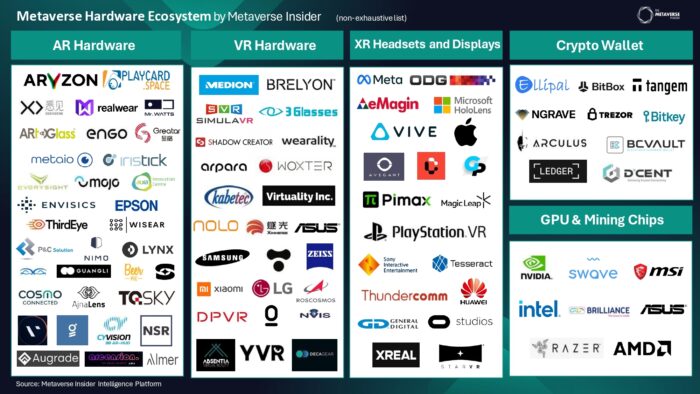As we assess the current state of the Metaverse, the hardware ecosystem emerges as the bedrock upon this next iteration of the internet. Below is a detailed but non exhaustive market map of the Metaverse hardware industry, outlining key classifications and categories dedicated to the sector. Let’s delve into a select few companies from each category, each contributing distinct innovations to shape the future of immersive experiences as well as web3 related ones.

Virtual Reality (VR) Hardware:

- Samsung: Samsung Electronics, a prominent figure in consumer electronics, IT, and mobile communications, has made notable strides in virtual reality (VR). Among its achievements is the Samsung Odyssey, a VR headset produced in collaboration with 3Glasses. Samsung’s partnership with 3Glasses underscores its commitment to delivering immersive experiences to users. Additionally, Samsung has expanded its VR lineup with the Samsung Odyssey+, another VR headset, this time developed by Fujitsu.
- Oculus Studios: A subsidiary of Facebook, Oculus Studios stands at the forefront of VR content creation, enriching the virtual landscape with captivating experiences through it’s Meta Quest headsets such as Quest 3. Collaborating with hardware partners, Oculus Studios amplifies the potential of VR technology, driving forward the evolution of immersive storytelling and social interaction.
- HTC Vive: The HTC Vive, created by HTC Corporation, is a virtual reality headset that delivers an immersive VR, enabling users to delve into virtual, augmented, and mixed reality worlds. Bundled with controllers, this headset is tailored for PC use. It boasts reliable tracking features and has garnered positive feedback from users due to its immersive qualities.
Augmented Reality (AR) Hardware:
- Microsoft HoloLens: Microsoft HoloLens, crafted by Microsoft, is an augmented reality (AR) and mixed reality (MR) headset. It stands as an untethered, self-contained holographic tool tailored for business purposes, furnishing applications aimed at bolstering user efficiency and precision. Priced at $3,500, the HoloLens 2 introduces comprehensive hand tracking, enabling users to engage with holographic elements seamlessly.
- Nreal (now XREAL): Xreal, formerly known as Nreal, is a Chinese firm recognized for its augmented reality eyewear. With a shift in branding, the company retains its commitment to delivering cutting-edge AR solutions. The XREAL Light, previously named Nreal Light, serves as their spatial computing platform, fully compatible with the latest NRSDK, ensuring an immersive AR encounter.
- Mojo Vision: Mojo Vision is a company known for its innovative augmented reality (AR) contact lens technology. They have developed a prototype AR contact lens that integrates a MicroLED display, offering a unique AR experience. The company’s focus on MicroLED displays has led to advancements in creating the world’s smallest and densest dynamic display
XR Headsets and Displays:
- Apple: The arrival of the Apple Vision Pro marks a significant advancement in XR technology, solidifying Apple’s dominant presence in the field. This cutting-edge headset introduces groundbreaking features that redefine our interaction with digital content. With the ability to respond to light and cast shadows, it offers an unparalleled mixed-reality experience, seamlessly blending virtual elements with the real world. Leveraging spatial computing, users can effortlessly control the device using hand gestures, eye movements, and voice commands. This intuitive interface allows for fluid app navigation and immersive interactions, enhancing the overall user experience.
- Magic Leap: Fueled by its vision of spatial computing, Magic Leap challenges the boundaries of reality with its Magic Leap line of headsets. Offering a portal to mixed reality experiences, Magic Leap empowers users to interact with digital content in their physical surroundings, laying the groundwork for new forms of storytelling, entertainment, and productivity within the Metaverse. One of these headsets the The Magic Leap 2, an advanced augmented reality (AR) headset, stands out for its state-of-the-art features and capabilities. With a price tag of $3,299, the Magic Leap 2 (ML2) boasts enhanced comfort, increased power, and a notably wider field of view compared to earlier models. Engineered for extended wear and accommodating multiple users across diverse sectors, this headset sports a lightweight, ergonomic design.
- Sony Interactive Entertainment: Beyond its acclaimed PlayStation VR platform, Sony Interactive Entertainment explores the realms of mixed reality with its XR headsets. Leveraging its expertise in gaming and entertainment, Sony seeks to blur the lines between the virtual and physical worlds, delivering immersive experiences that captivate the senses and ignite the imagination. Currently Sony, has released two PlayStation VR headsets dedicate to gaming and has partnered with Siemens to release a new XR headset focused on content creation using spatial computing.
GPU & Mining Chips:
- NVIDIA: At the heart of the Metaverse lies the processing power that fuels its immersive experiences, and NVIDIA’s GPUs stand as a beacon of computational prowess. From powering lifelike virtual environments to driving real-time interactions in augmented reality, NVIDIA’s graphics technology sets the standard for visual fidelity and performance within the Metaverse. NVIDIA also owns a platform called Omniverse, a 3D digital twin simulation platform used by leading industrial Metaverse players.
- AMD: With its Radeon graphics cards, AMD contributes to the advancement of VR and AR technology, delivering high-performance solutions for demanding applications. From gaming to content creation, AMD’s GPUs empower users to push the boundaries of what’s possible within the immersive realms of the Metaverse.
- Intel: As a key player in the semiconductor industry, Intel plays a vital role in shaping the future of VR and AR hardware. From powering next-generation XR headsets to optimizing software for immersive experiences, Intel’s commitment to innovation drives forward the evolution of the Metaverse, ensuring that users remain immersed in stunning and lifelike digital worlds.
Crypto Wallets:
- Ledger: Amidst the digital landscapes of the Metaverse, security is paramount, and Ledger’s hardware wallets provide peace of mind for users navigating the world of cryptocurrencies. With robust encryption and user-friendly interfaces, Ledger ensures that users’ digital assets remain secure, empowering them to explore the Metaverse with confidence.
- Trezor: Another leader in hardware wallets, Trezor provides users with a secure and user-friendly way to manage their cryptocurrencies. With its emphasis on privacy and security, Trezor offers a trusted solution for safeguarding digital assets within the Metaverse, enabling users to explore new frontiers without compromising their financial sovereignty.
- Ellipal: Ellipal is a prominent brand in the cryptocurrency industry, offering hardware wallets designed to securely store various cryptocurrencies. The Ellipal Titan 2.0 is a highly regarded hardware wallet known for its security features, including air-gapped technology and full metal construction to protect against tampering and hacking attempts.
For those eager to explore the full spectrum of companies shaping the Metaverse hardware ecosystem, our Metaverse Intelligence Platform offers an unparalleled resource. With comprehensive profiles and insights, our platform maps the entire market, providing a detailed overview of each company’s products, innovations, and contributions.
Whether you’re a developer seeking the latest VR headset or an investor tracking emerging trends in AR technology, our platform equips you with the knowledge needed to navigate the ever-evolving Metaverse hardware market with confidence and enables you to stay ahead of the curve with our Intelligence Platform.
If you found this article to be informative, you can explore more current Digital Twin news here exclusives, interviews, and podcasts.













